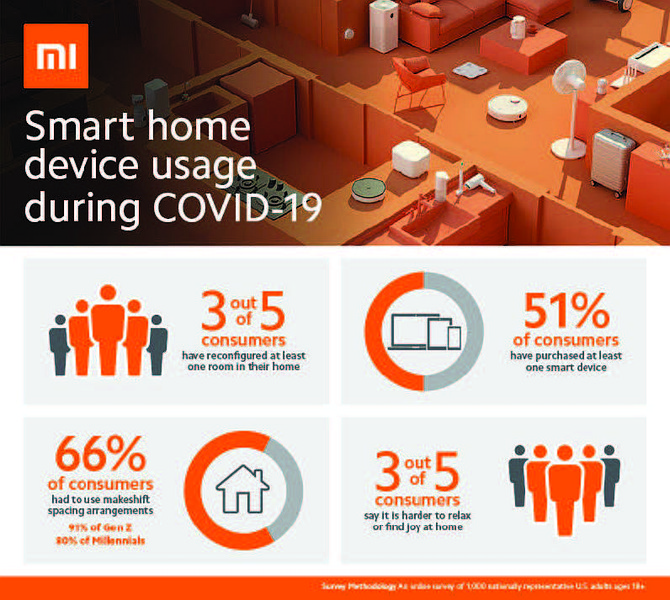New survey finds 70% of consumers improved home during COVID-19, more than half used smart devices
Stay-at-home orders changed the very notion of how people interact and live in their homes, driving people to reconfigure their physical space to meet new functional requirements, including working and learning at home, creating at-home gyms, or finding new ways to relax and enjoy themselves.
The survey found that 3 out of 5 respondents said that since their leisure and work environments have become one, it has become harder to carve out personal space to relax and find joy at home. Of those, 63% purchased smart home devices, 82% adapted a room for working from home during COVID, and 79% reconfigured at least one room.
“Smart living has always been about reimagining and optimizing physical space to solve problems and adapt to new realities through the use of technology, and we’ve seen this adoption accelerate in 2020,” said Daniel Desjarlais, global product marketing manager at Xiaomi. “Connected homes, automated systems, and new technology are helping people create ecosystems within their homes to solve new challenges presented by increased time at home, whether it’s adapting or creating new uses for old spaces, such as office space or classrooms, or just creating a more streamlined home that is easier to manage and control.”
Key survey findings include:
* People had to adapt existing spaces to serve new purposes, particularly younger generations: Makeshift spacing arrangements were widespread across all age groups, with nearly two-thirds (66%) of all respondents saying that they had to use makeshift spacing arrangements in response to staying home more during the pandemic. This was particularly pronounced among Gen Z and Millennials -- 91% of Gen Z consumers and 80% of Millennials indicated this was something they were forced to do.
* Smart home device purchases were a solution: On average, consumers bought two new smart devices since March in response to being home more during the pandemic, with Gen Z consumers buying an average of three. Smart devices can help to streamline a space and provide solutions for problems generated by more time at home, such as the need to carve out specific work or study space. Regardless of devices purchased, there is an overwhelming consensus among consumers (82%) that there are significant advantages to a home with smart devices.
* For many, these makeshift solutions may end up being permanent. According to a press release, 60% of consumers say they plan to continue using their home for activities typically performed elsewhere, even after a COVID-19 vaccine is widely available. If stay-at-home orders go into effect again in 2021, nearly 2 in 5 (39%) of consumers have reported that they want to upgrade their devices and 41% will adapt a room. In 2021, the adoption and integration of smart home technology will be a prevailing trend in home improvement as consumers look to smart devices as part of their long-term solutions.
As of September 30, 2020, the number of users with five or more devices connected to Xiaomi’s AIoT platform reached 5.6 million. Much of Xiaomi’s growth is coming from overseas markets, including expansion into Western markets. The newest product to be readily available for U.S. consumers is Mi Air Purifier 3H, which went on sale on January 14, 2021.
The Xiaomi Survey was conducted by Wakefield Research (www.wakefieldresearch.com) among 1,000 nationally representative U.S. adults ages 18+, between December 11th and December 16th, 2020, using an email invitation and an online survey.
For more information on Xiaomi and their smart home ecosystem, visit mi.com.
Latest Stories
- Happy New You!
- Is It Normal Aging or Early Dementia? Memory Loss Causes and Alzheimer’s Warning Signs to Watch For
- Chicago Sinfonietta To Host ‘Open Heart’ Concert
- State Of The Southland: Village of Matteson
- Local Woman Looks To Change Narrative Around Having Locs
Latest Podcast
Wendy Thompson-Friend Health

